The Santa Cruz Mountains, which run north-south just to the west of the Silicon Valley and south of San Francisco, are pinched in between the tech capital of the world and the Pacific Ocean. These mountains, which top out at a modest 3,800 feet, can be surprisingly rugged with deep canyons and steep slopes. The western slope gets the brunt of the fog effect and is the traditional habitat for the massive coastal Redwood Forest. The original old growth redwoods have all but disappeared from the region, there’s only a scattered few that survived the logging binge of the late 1800s. Today it is interspersed mostly with second growth redwoods, Douglas firs and grasslands for cattle grazing.
The eastern slopes are covered with a mixed soft and hardwood forest. Mostly made up of various varieties of oaks, madrones, California bay laurels, some Douglas fir and redwoods. The understory can be a mixture of manzanita, invasive broom species and an over-abundance of poison oak. Much of this land, on either side, is publicly owned by the state or county and heavily regulated, or privately owned by environmental foundations or trusts that limit development and activities. Local hunting opportunities for the landless are extremely limited in the region.
However, lightly interspersed between the parks, trusts, open space and easements are the neatly placed rows of vineyards, dotting both the eastern and western slopes. As a side gig, I farm a few of these local vineyards, more for my passion for wine, but it has given me the chance to hunt locally.
Veraison is the French term for when wine grapes, still hanging on the vine, begin to turn color, from green to purple and eventually black. It means that the grapes are going from hard and acidic to softer and sweeter. In the Santa Cruz Mountains, this is the moment we start covering the vineyards with nets. The ever-perceptible bird population can see, just like us, that the grapes are getting taste worthy, and they just can’t help themselves. Apparently, neither can wild turkeys.
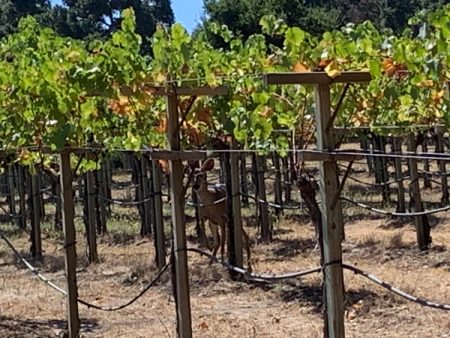 On one vineyard site in particular, managed by a friend of mine, a flock of about two dozen turkeys were wreaking havoc on the ripening grapes. The owner refused to use nets and my friend had estimated that they had already caused $15,000 worth of loss when he finally called me. He spent a lot of time convincing the owner to reduce the turkey population. Hesitant, she finally agreed, and he applied for and received three out-of-season depredation tags for a male or a female. But the owner was pretty adamant about not shooting any females.
On one vineyard site in particular, managed by a friend of mine, a flock of about two dozen turkeys were wreaking havoc on the ripening grapes. The owner refused to use nets and my friend had estimated that they had already caused $15,000 worth of loss when he finally called me. He spent a lot of time convincing the owner to reduce the turkey population. Hesitant, she finally agreed, and he applied for and received three out-of-season depredation tags for a male or a female. But the owner was pretty adamant about not shooting any females.
A discreet middle-aged woman with an earthy aura, she had inherited the vineyard and winery from her parents and now ran it along with her other siblings. The first time I met her, she was very inquisitive about my passion and motives. In an almost accusatory tone she asked me, “Why do you hunt?” Now I’ve been asked this question on several occasions before, so I’ve had plenty of experience in reflecting on it as well as explaining it. I also understand the greater context at stake, in the presence of a skeptic, I try to represent the world of archery, the traditional community and ethic as best I can.
Although, she apparently had a problem with hunting in general, she did like the idea that I hunted with bow and arrow. In part because the vineyard/winery is situated just outside of a small town whose inhabitants are not the most favorable toward hunting. She was afraid that the sound of a shotgun might get too many people too curious. Also, I believe that the nostalgia of hunting with a longbow resonated with her somehow. I presented ‘why I hunt’ in the most basic way I could, for the love of the bow at full-draw, and the sensation of a well-shot arrow arcing beautifully through the air, for the closeness to wildlife it brings not just my quarry, but mostly because ‘I have to’.
She went on to explain to me that although the vines were under the management and responsibility of my friend, the responsibility for the overall health of the property was hers. And she wanted to be certain that I wasn’t going to jeopardize that. I understood, of course, and I assured her that I wasn’t there to terrorize the turkeys nor upset the balance of her ecosystem. Rather, I explained, I approach hunting with the deepest respect and humility toward her land and the animals which I intend to hunt. She wished me luck.
I had only a limited time period to hunt as the depredation tags expired in two weeks and the vineyard was going to be harvested probably sooner than that. I also had family and work constraints as well as the constraints from the property owner. I wasn’t allowed to set up any decoys or a blind and I was only allowed on the property early morning or late afternoon as to avoid any contact with clients or other passersby. That suited me just fine, as that’s when I figured the turkeys would be moving around the most.
I haven’t had too much experience with hunting turkeys, only on a few occasions in my home state of New Hampshire when I was much younger, so there was a bit of a learning curve as well. As this wasn’t during the breeding period, I felt that a turkey call wouldn’t be very effective either and to be honest, I was a bit rusty with my calls. So, it was pretty much me and my bow, which in the grand scheme of things is the way it should be and just the way I like it.
On the afternoon that I met her at the vineyard, I was able to walk the front property, bow-less of course, to get the lay of the land. There were several different vineyard blocks, mostly Pinot Noir and Chardonnay, the turkeys seemed to prefer the darker Pinot, so I concentrated my initial scouting to these blocks. There was plenty of cover surrounding the sites as well, much of it poison oak, which made sitting in these spots a delicate endeavor.
On the front block, I spotted some birds, mostly hens, jakes and jennys. As an experiment, I decided to see just how close I could get to them before they spooked. I thought that I might be able to get quite close as the turkeys had likely never been hunted and were used to seeing humans in the vineyard crew. Pretending to tend the vines, I managed to get within 25 yards of them before they got spooky and walked quickly to a comfortable distance. In light of all of my other constraints, this at least seemed to be a positive note. However, shooting while actually in the vineyard would be very difficult unless they were in the row that I was in, and then the shooting window would only be for a few seconds as they passed through. I decided my best option would be to find a well-travelled spot just on the outside of the block and try to position myself for a shot either as they were going from cover to the vines or vice versa.
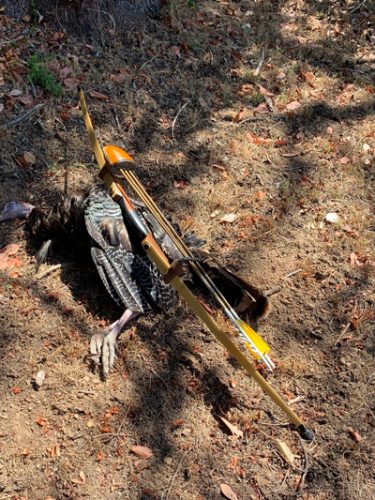
On the way back to my car, I ran into my friend who, after talking with some of the vineyard crew, pointed to a large oak tree just off a lower block that the turkeys often roosted in. This was another Pinot block that was fairly secluded on the property, probably an ideal spot for turkeys to gorge themselves on the sun-ripened sweet grapes. I could see the vineyard block and oak tree from where I parked my car. It looked interesting. As it was practically evening now and it was off the beaten path, I decided to take my bow this time, just in case. With my buddy we started to head down the steep hill to get to the small vineyard, when I could faintly hear the clucking and purring of hens in the distance.
On a hunch that they were on the eastern or downslope side of the vineyard, just adjacent the oak tree, or even in the shade of it, I sent my buddy around the north side to come up behind them, while I left the clearing that we were in to get into a small live oak grove southeast of where I thought the turkeys were. My hope was that my buddy could approach them delicately and nudge the birds toward me a bit. I never expected to get a shot off, I was more interested in seeing how the birds reacted to the pressure and seeing which direction they headed in.
I had placed myself in front of an old wide silvery oak and waited. Although not too abundant, we can get 300-400-year-old oaks in this part of California whose trunks are 6ft in diameter. Sure enough the birds began to get spooky and started walking southeast out from the shade of their tree and into the clearing that I was looking over. Mostly hens, there were a few jakes and younger toms, and one of them, a medium-sized younger gobbler walked in front of my view, stopped and turned his back. Normally at this distance I’d hesitate to take that shot, guessing about 40-45 yards, but the conditions seemed too perfect, it was a flat shot, in a clearing, on a bird that wasn’t really moving with his back turned. My buddy was a safe distance off to the left of my intended trajectory, so that wasn’t an issue either. I picked a spot on that tom’s back and let an arrow fly.
It arced beautifully into his upper back, popping him into the air, he took another step and then fell to the ground. The rest of birds took to the woods in a hurry. I scurried from the oak grove up to where he lay. He was lifeless already, it was a clean shot through his back, the broadhead protruding slightly through his chest. Picking him up I brought him over to the shade and I nocked another arrow to see if I could possibly pursue the other birds that went just beyond the tree line, but it was some pretty dense cover and full of poison oak. I could hear them, as they weren’t that far off, but I decided that pursuing them probably wouldn’t bear any fruit.
We brought the bird back up to the car. He had to leave but said that no one would be coming on to the property for the rest of the day, so I could explore. I gave him a big smile and a thumbs up, grabbed my bow and started walking.
I glassed a group of birds between that upper block and the tree line, grubbing around the dried grass. I figured that instead of sneaking up on them I might just be able to walk rather nonchalant right up to them, pretending to work the vines. I rounded the corner of the last vine row and then preoccupied myself with the vines, while I slowly inched toward them. They didn’t seem to take any notice. But once I crossed the 40-yard threshold they pushed farther down the vine row. It looked like there were a few smaller toms and jakes in the group, so I decided not to push too hard. They were nearly out of site now, being down a little knoll, so I peeled off the vines and worked my way upward into a clump of bushes between the tree line and that last vine row. I had a better look at them now, they were still grubbing, not too alarmed. I took a knee behind one of the bushes and decided to wait.
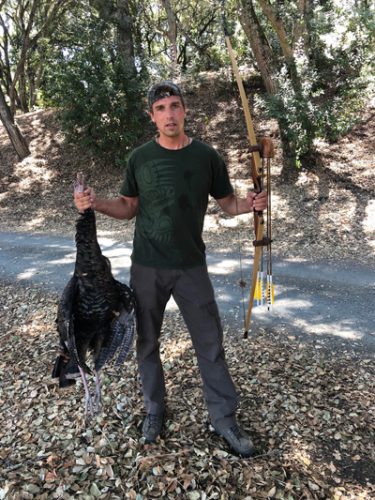
Within 20 minutes they began to work themselves back toward me, beaks to the ground. Within a short while a modestly bearded tom made his way to within 25 yards. I pulled back the string and let an arrow fly, for what I thought was a sure thing. The arrow flew just above his back, skipping downhill into the vineyard. Missed! The rest of the birds got excited and rambled around a bit and then settled down, meanwhile I nocked another arrow. That same tom once again came within 25-30 yards, I pulled back the string, again let an arrow fly. Missed again! I could see the plumage skipping off into the vineyard below. This time the birds took to the woods and didn’t return. I decided it would be best to get my bird out of the heat, so I returned to the car much more humbled this time than last.
On the very next occasion, on a cool and foggy morning, I stumbled upon a group of six older, bigger and well-bearded toms, grubbing in the center of a wide field just adjacent that first vineyard where I had shot. These guys walked right down the center of the field, through patches of shifting fog, a safe distance from either side. After my last two shots I wasn’t feeling too confident with the distance and hesitated too long. They passed through pretty quickly and into cover. I would never see them again. Sometimes I wish that I had tempted it, but in general I trust my instincts in the moment and prefer not to analyze too much the “should haves”.
I was able to get back to the property another two times before the grapes were harvested and the depredation tags expired. By far the best chance I had was on the first day. The turkeys were less timid and getting close to them wasn’t as problematic as the other times, especially given the constraints on what and where I was allowed to hunt. In the greater context, the owner who was pretty skeptical of hunting in the beginning, saw the merits and appreciated a traditional approach and my lightness on the land. She would invite me back again that following spring. Not surprisingly, a nice breaded and fried cutlet of that turkey breast went beautifully with a glass of the estate Pinot.


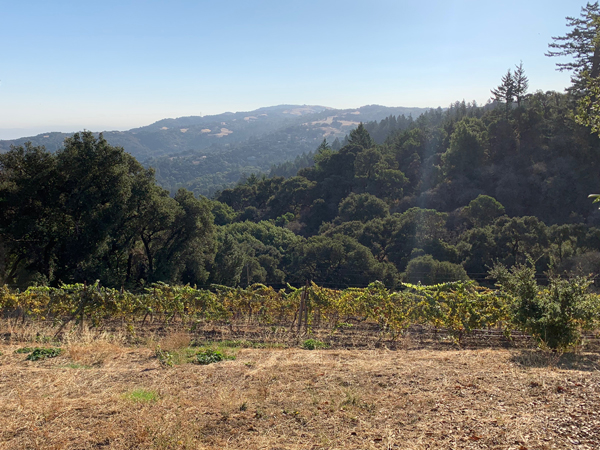


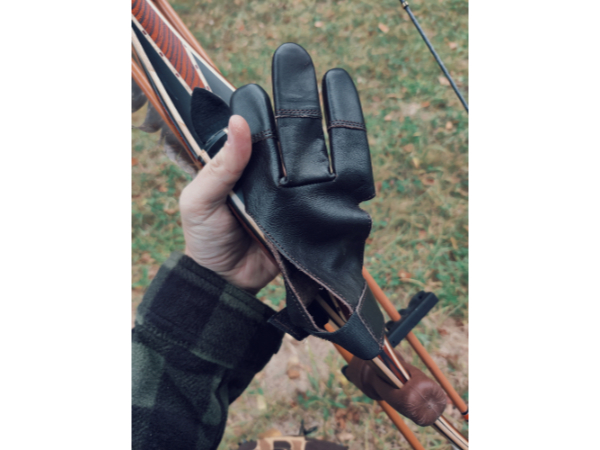

Leave A Comment